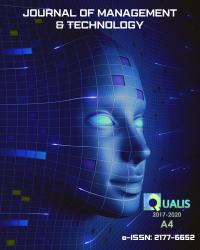Prospects for using blockchain in the system of international supply chains and cross-border payments
DOI:
https://doi.org/10.20397/2177-6652/2023.v23i4.2692Palavras-chave:
Blockchain, Transnational payment systems, Economic security, Sanctions pressure, International supply chains, Digital transformationResumo
This article considers the transformative potential of blockchain technology and digital currencies in revolutionizing national and international payment systems. The study employs a comprehensive analysis of existing literature, real-life cases, and current trends in blockchain and digital currency adoption. It assesses the impact of blockchain on international trade and financial transactions, focusing on its potential to reduce costs, enhance security, and improve transparency. The research reveals that blockchain offers promising solutions for cross-border payments by eliminating intermediaries, reducing transaction costs, and increasing the efficiency of supply chains. Central bank digital currencies are gaining traction as central banks strive to modernize payment systems and mitigate risks associated with legacy clearing systems. The study also highlights the emergence of regional payment systems and country-specific associations driven by blockchain adoption, enabling autonomous payment transactions independent of traditional regulatory mechanisms. The article emphasizes the importance of exploring alternative channels for international transactions and embracing these technologies to navigate the evolving landscape of cross-border payments. Ultimately, the potential of blockchain to accelerate transactions, reduce costs, and enhance security makes it a transformative force in reshaping the future of international and national payment systems.
Referências
Allen, D. W. E., Berg, C., Davidson, S., Novak, M., & Potts, J. (2019). International policy coordination for blockchain supply chains. Asia & the Pacific Policy Studies, 6(3), 367-380.
Alonso, N., Luis, S., Javier, J.-V., Forradellas, R., & Francisco, R. (2021). Central banks digital currency: Detection of optimal countries for the implementation of a CBDC and the implication for payment industry open innovation. Journal of Open Innovation: Technology, Market, and Complexity, 7(1), 72. https://doi.org/10.3390/joitmc7010072
Auer, R., Cornelli, G., & Frost, J. (2020). Rise of the central bank digital currencies: Drivers, approaches and technologies. BIS Working Papers No. 880. https://www.bis.org/publ/work880.htm (accessed on March 28, 2023).
Boar, C., Holden, H., & Wadsworth, A. (2020). Impending arrival – A sequel to the survey on central bank digital currency. BIS Papers No. 107. https://www.bis.org/publ/bppdf/bispap107.pdf
Boar, C., & Wehrli, A. (2021). Ready, steady, go? Results of the third BIS survey on central bank digital currency. BIS Papers No. 114. URL: https://www.bis.org/publ/bppdf/bispap114.pdf
Civelek, M., Ključnikov, A., Kloudová, J., & Vozňáková, I. (2021). Digital local currencies as an alternative digital payment method for businesses to overcome problems of COVID-19 pandemic. Polish Journal of Management Studies, 23(2), 57-71. https://doi.org/10.17512/pjms.2021.23.2.04
Clarke, R. (2003). Libertarian accounts of free will. Oxford; New York: Oxford University Press.
Cunha, P. R., Melo, P., & Sebastião, H. (2021). From Bitcoin to central bank digital currencies: Making sense of the digital money revolution. Future Internet, 13(7), 165. https://doi.org/10.3390/fi13070165
Davoodalhosseini, S., & Mohammad, R. (2018). Central bank digital currency and monetary policy. Bank of Canada Staff Working Paper No. 2018-36. http://hdl.handle.net/10419/197889
Egorsheva, N. (2023, March 20). TsB obyazal banki s oktyabrya ispolzovat tolko rossiiskie servisy po vnutrennim perevodam [The Central Bank obliged banks to use only Russian services for internal transfers from October]. https://rg.ru/2023/03/20/cb-obiazal-banki-s-oktiabria-ispolzovat-tolko-rossijskie-servisy-po-vnutrennim-perevodam.html?utm_source=yxnews&utm_medium=mobile&utm_referrer=https%3A%2F%2Fdzen.ru%2Fnews%2Fstory%2FCB_obyazal_banki_soktyabrya_ispolzovat_tolko_rossijskie_servisy_povnutrennim_perevodam--b54019982759db1f4d0b5865b2f56ec2#bounce (accessed on March 21, 2023).
Engert, W., & Fung, B. S. C. (2017). Central bank digital currency: Motivations and implications. Bank of Canada Staff Discussion Paper 2017-16. https://www.bankofcanada.ca/wp-content/uploads/2017/11/sdp2017-16.pdf
European Parliament, Directorate-General for Parliamentary Research Services, Copigneaux, B., Vlasov, N., Bani, E., Tcholtchev, N., Lämmel, P., Fuenfzig, M., Snoeijenbos, S., Flickenschild, M., Piantoni, M., & Frazzani, S. (2020). Blockchain for supply chains and international trade. Report on key features, impacts and policy options. Brussels: European Parliament. https://doi.org/10.2861/957600
Fernández-Villaverde, J., Sanches, D., Schilling, L., & Uhlig, H. (2021). Central bank digital currency: Central banking for all? Review of Economic Dynamics, 41, 225-242. https://doi.org/10.1016/j.red.2020.12.004
Ganne, E. (2018). Can Blockchain revolutionize international trade? Geneva: World Trade Organization.
Goodell, G., Al-Nakib, H. D., & Tasca, P. (2021). A digital currency architecture for privacy and owner-custodianship. Future Internet, 13(5), 130. https://doi.org/10.3390/fi13050130
Kochergin, D. (2021). Tsifrovye valyuty tsentralnykh bankov: Mirovoi opyt [Digital currencies of central banks: Global experience]. Mirovaya ekonomika i mezhdunarodnye otnosheniya, 65(5), 68-77. https://doi.org/10.20542/0131-2227-2021-65-5-68-77
Kshetri, N. (2021). The economics of Central Bank digital currency. Computer, 54(6), 53-58. https://doi.org/10.1109/MC.2021.3070091
Mancini-Griffoli, T., Peria, M. S. M., Agur, I., Ari, A., Kiff, J., Popescu, A., & Rochon, C. (2018). Casting light on central bank digital currencies. IMF Staff Discussion Notes, 18(8), 1. http://dx.doi.org/10.5089/9781484384572.006
OECD. (2019). The policy environment for blockchain innovation and adoption: 2019 OECD global blockchain policy forum summary report. OECD Blockchain Policy Series. http://www.oecd.org/finance/2019-OECD-Global-Blockchain-Policy-Forum-Summary-Report.pdf
Okazaki, Y. (2018). Unveiling the potential of blockchain for customs. WCO Research Paper No. 45. https://www.wcoomd.org/-/media/wco/public/global/pdf/topics/research/research-paper-series/45_yotaro_okazaki_unveiling_the_potential_of_blockchain_for_customs.pdf
Ozili, P. K. (2023). Central bank digital currency research around the world: A review of literature. Journal of Money Laundering Control, 26(2), 215-226. https://doi.org/10.1108/JMLC-11-2021-0126
Safiullin, M. R., Yelshin, L. A., & Abdukaeva, A. A. (2019). Integralnaya mnogokomponentnaya otsenka razvitiya rynka blokchein-tekhnologii v natsionalnoi ekonomike Rossii [Integral multi-component assessment of the development of the blockchain technology market in the national economy of Russia]. Innovatsii, 7(249), 41-49.
Sidorenko, E. (2021). Tsifrovaya valyuta tsentralnykh bankov ekonomicheskie stsenarii i prognozy [Digital currency of central banks economic scenarios and forecasts]. Mezhdunarodnye protsessy, 19(2), 151-165. https://doi.org/10.17994/IT.2021.19.2.65.8
Tapscott, D., & Tapscott, A. (2017). How blockchain will change organizations. MIT Sloan Management Review, 58(2), 10-13.
Tong, W., & Jiayou, C. (2021). A study of the economic impact of central bank digital currency under global competition. China Economic Journal, 14(1), 78-101. https://doi.org/10.1080/17538963.2020.1870282
World Economic Forum. (2019). Windows of opportunity: Facilitating trade with blockchain technology. WEF White Papers. https://www3.weforum.org/docs/WEF_Windows_of_Opportunity.pdf
Zhang, T., & Huang, Z. (2021). Blockchain and central bank digital currency. ICT Express, 8(2), 264-270. https://doi.org/10.1016/j.icte.2021.09.014
Downloads
Publicado
Como Citar
Edição
Seção
Licença
Copyright (c) 2023 Revista Gestão & Tecnologia

Este trabalho está licenciado sob uma licença Creative Commons Attribution-NonCommercial 4.0 International License.
Os direitos, inclusive os de tradução, são reservados. É permitido citar parte de artigos sem autorização prévia desde que seja identificada a fonte. A reprodução total de artigos é proibida. Em caso de dúvidas, consulte o Editor.


